Thursday, October 21 dawned grey and overcast for the various Sustainable Toronto Green Roof Tours offered by the CitiesAlive! World Green Roof Infrastructure Congress, with a promise of sprinkles in the air. Aramis and I headed over to the Tremco Luxury Bus Tour line and since it was the most popular, there were two buses. We got the smaller of the two “Luxury Coaches” and indeed they were luxurious, with some distinct design accents!
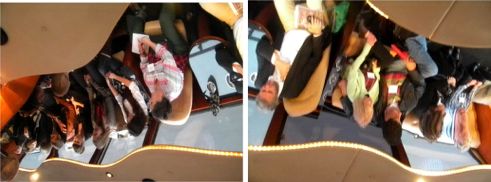
Plush interiors with overhead strip lighting on the mirrored ceiling and four Captain’s chairs set the mood and so we dubbed ours the “Party Bus.” Since we were the first in line, Aramis and I claimed the super comfortable seats, along with friends Lauren Gould from Miami and Manfred Köhler from Berlin. Everyone got a choice of a selection of boxed lunches, which by the way was very good, and Tremco had provided umbrellas which was thoughtful since we did need to use them later.
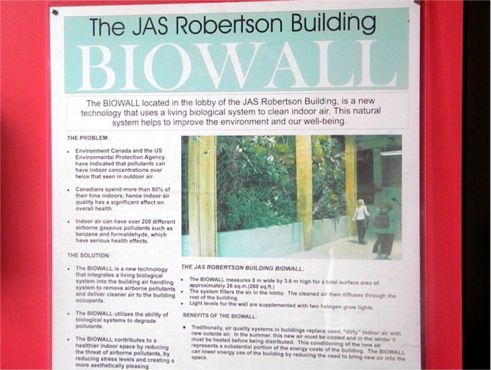
Paul Sheehy of Tremco and Rick Buist of Bioroof were our bus hosts and after about a 40-minute delay – there was some confusion about the departure time – we were on our way to our first stop, The JAS Robertson Building, also known as 215 Spadina. Erin MacKeen from Urban Space Property Group, the client/developer, ushered us into the main lobby and we were pleasantly greeted with a lush, beautiful 8m wide x 3.6m high (24 m ² or about 258 sf) Nedlaw living wall, with design by Beth Anne Currie.
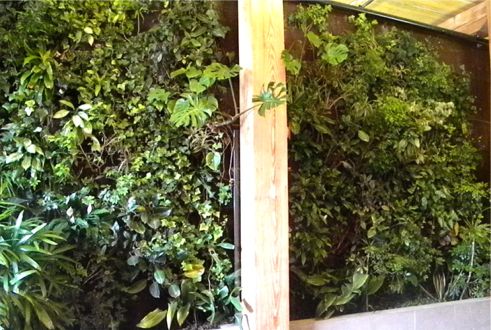
The Robertson Biowall‘s soil-less system recycles the nutrient rich irrigation continuously and has two one thousand watt light system grow lights that provide some seasonal UV light, which are on about four hours/day. Several varieties of native and exotic indoor flowering plants are set in pockets of a special fabric and the effect is stunning – the wall looks like a scene taken from a tropical jungle.
We then went up atop the 5th floor to see the lovely 4,000 sf extensive greenroof, which is enjoyed by the 40 tenants and visitors to the Robertson Building. Since this is a Bioroof system above the membrane, Rick led this portion of the tour. We emerged from an enclosed 400 sf glass atrium onto the wood deck viewing platform, which offered great views of the cityscape.
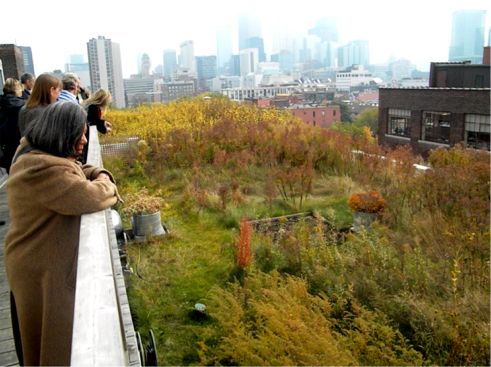
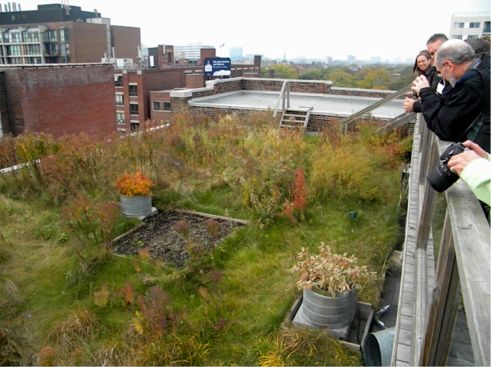
Designed and installed by Gardens in the Sky in 2004, half of the roof is vegetated and this is Toronto’s earliest urban example of a meadowlike roof, left to naturalize. Planted with over 10 species of Ontario native perennials, including Green-Headed Coneflowers, New England Asters, Goldenrod, and Black-Eyed Susans, the 6″ deep growing medium is highly organic at about 40%, which actually has the same proportions as when initially installed. Left to their own measures the plants have really flourished – what a lovely wild looking roof! And at the time, no previous greenroof had been designed specifically with biodiversity as its motivating factor, and as a result, the roof has become a “poster greenroof” for the City of Toronto and its greening efforts. Aside from biodiversity of plants, the living roof also has a variety of other animals including bees, butterflies, and birds. Energy retrofits of the Robertson Building include a solar thermal system, and the tenants are so happy with the many environmental features of the building that there is a waiting list for new ones.
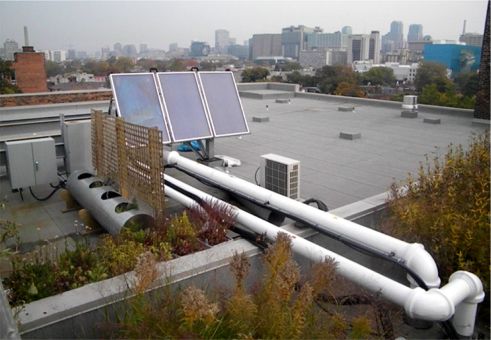
Next up we visited the gorgeous Covenant House Toronto greenroof, also using a Bioroof system, this time over a Tremco waterproofing membrane. John, the Physical Facilities Manager, and Shawn from Tremco escorted us through this welcoming, beautiful, and secure building. Covenant House Toronto is an emergency shelter for runaways and homeless youth for ages 16-24. Although some stay for months, the average stay here is five days, and many of the young people return often for continuing educational support or sometimes just a hot meal and a warm, safe bed to sleep at night. The director showed us an informative and heartwarming video in the words of former residents about their experiences and how the caring and nurturing of the dedicated staff helped them transform into successful adults today.
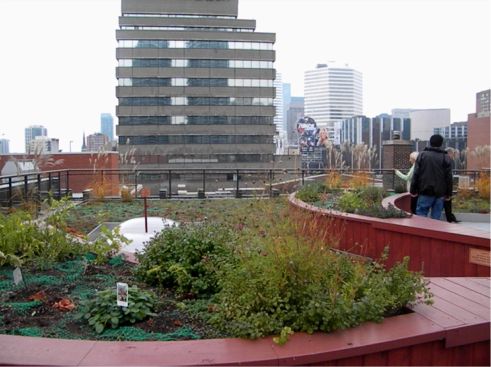
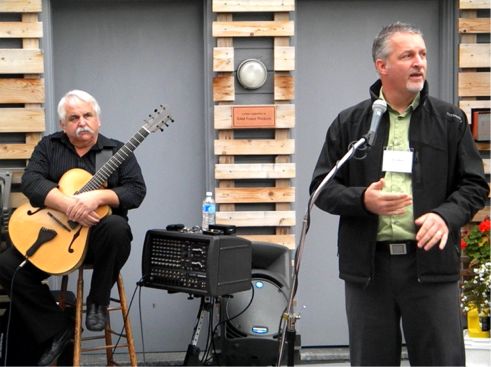
Bioroof added a unique touch and set a mellow mood on the roof by providing a jazz guitarist as we toured the 7,200 sf roof. Approximately 5,000 perennials, raised vegetable planters, a wetland area, a fish pond with a fountain, and an overhead trellis are just some of the features of this outdoor classroom. Designed to comply with the City of Toronto’s Green Roof Incentive Pilot (now Eco-Roof Incentive Program), Rick explained the numerous sustainable features of the 6″ deep extensive greenroof which incorporates 12″ intensive planters with built in seating. Each of the intensive planted areas are used for a particular educational program, and the vegetables (tomatoes, peppers, various herbs, etc.) are used in the kitchen.
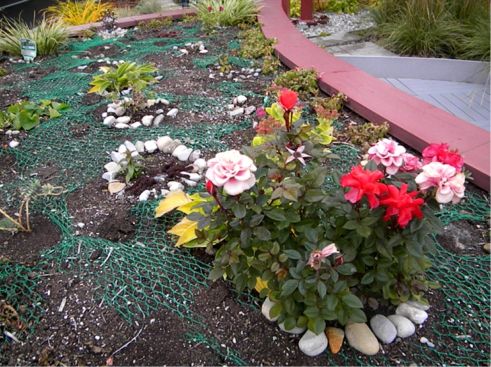
Photodegradable netting is used as erosion control throughout. The focal area concentrates on the area of the curving steel and wood arbor, with a variety of plantings, hanging baskets and a unique feature – a dry river bed. More than simply decorative, it collects water here and directs it to the single roof drain.
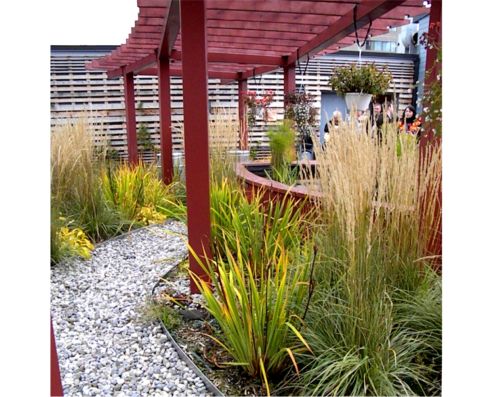
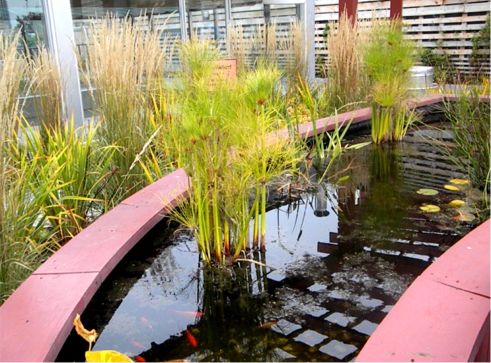
And the kids love the goldfish in the elevated pond! Filled with water plants, it also introduces sound with an umbrella spray, and you can sit on the ledge and touch the water – it’s an overall great design!
Afterwards we headed to the Toronto Water Treatment Plant where John Campbell of Tremco was our guide. Exploring the varied ideas of roof sustainability, we saw two types of cool white roofing installations side by side, a Building Integrated Photovoltaic (BIPV) system and a white calcite aggregate roof on an inverted, protected assembly by Tremco.
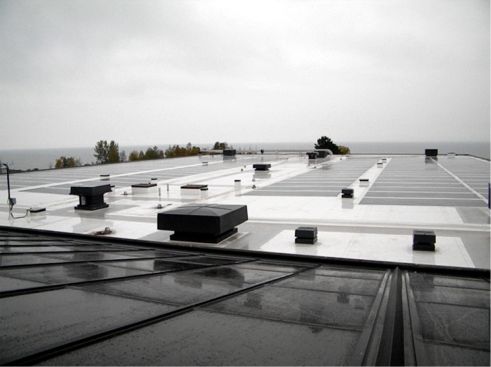
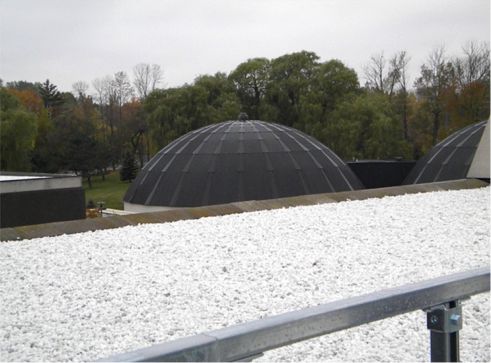
Although the BIPV roof was installed after the aggregate roof, the white aggregate roof looked much cleaner, and in fact we were told required minimal maintenance.
The final stop on our tour brought us to the large Tremco complex where Paul Sheehy, Ontario Manager at Tremco, was our host. Tremco treated us to lovely wine and cheese refreshments after our long day (very well received by all!). Paul also introduced his 19-year old daughter, Lynn Sheehy, a freshman in college who needed to interview three people for her journalism and communications class. She needed feedback on the CitiesAlive! Congress, and asked for volunteers after the program had finished.

Tremco has many years of experience in the roofing industry and now has over 1 million sf of greenroofs installed within Canada alone, with many more in the pipeline. So after Paul gave us some more history on Tremco and their company philosophy, we cautiously climbed up the steel rung ladder onto the roof in the light rain to see their highly efficient solar array installation with tracking system. Ashleigh Uiska of Fishburn Building Sciences Group very knowledgeably fielded some technical questions about the PV system – the Tremco engineer was just a bit late but answered more questions for us later.
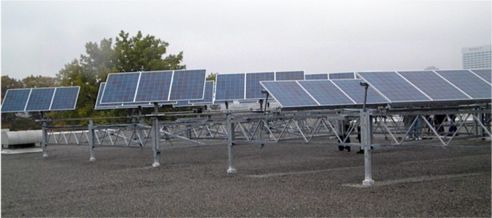
Rick then spoke about his company and range of products and demonstrated step-by-step how to install a Bioroof System, above the membrane. It’s always interesting to see exactly how systems are built, and Rick went into great detail about each layer and noted important installation aspects of each, especially around parapets, flashings, and edging. Everyone was given a parting gift of a pre-seeded jar with Bioroof Eco Mix growing media, but those of us crossing the border had to decline due to Customs regulations!
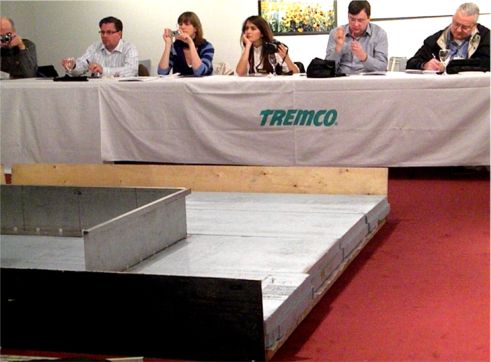
Prior to closing, Aramis felt the need to volunteer me to speak with Lynn since no one had volunteered themselves. She was really cute and I felt my interview was just rolling along when she ran out of tape…We suggested she also interview Lauren Gould, greenroof enthusiast, who attends many greenroof conferences as well as those from other green industries, to get her take on the Congress. After Lauren, Lynn spoke with Melanie Mullen, an environmental blogger from Canada who also covers the vegetated roof field.
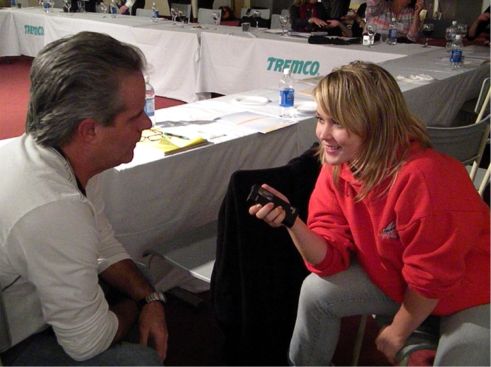
We all loaded back into the Party Bus for one last voyage to the CitiesAlive! Closing Gala at the Toronto Botanical Garden (TBG), where Terry McGlade of Gardens in the Sky was our host. He took us on a tour of TBG’s main greenroof designed by his company in 2005, planted with a colorful Sedum mix. Highly visible due to its slope, the 646 sf extensive greenroof ranges from 20 ° to 30 °. Soprema was the system used, and a geo-textile was included to ensure growing media retention. 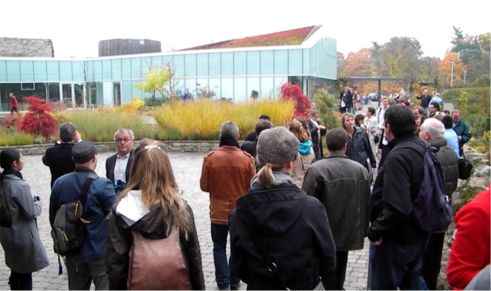
We also visited the smaller one located on the property, too. The Annie Shed is the first registered straw bale building in Toronto, constructed through two weekends of hands-on workshops. The vegetation on this roof was planted as part of a research effort by Ryerson University.
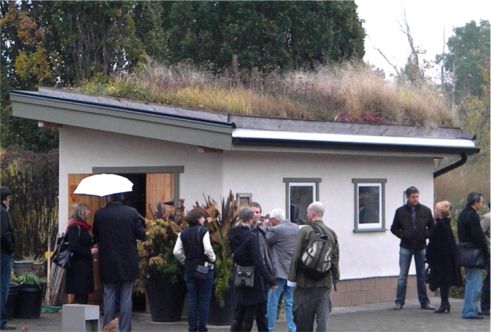
The Toronto Botanical Garden grounds are lovely and the abundunce of nicely tended flowering perennials, vine-clad walls, and beautiful trees in the gardens was appreciated by all on this autumn day.
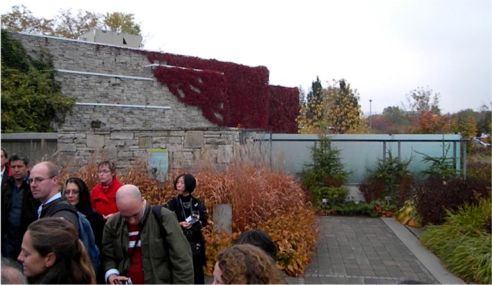
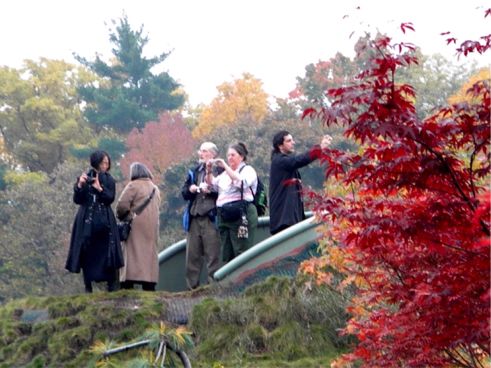
The Gala itself was a Mexican Fiesta celebration, honoring the host city for the second World Green Roof Infrastructure Network Congress: A Sustainable Alternative for Big Cities in Mexico City, to be held on October 7-9, 2010. Reception co-host Tanya Müller Garcia, President of WGRIN Mexico member AMENA (Asociación Mexicana para la Naturación de Azoteas), and Director of ‘Reforestacion Urbana, Parques y Ciclovia’ (Urban Forestry, Parks and Bikeways) in Mexico City, welcomed us and presented “Outstanding Public and Private Green Roofs Across Mexico.” Flowing margaritas and Corona beer, tasty food, and a lively Mariachi band gave us a preview for things to come at next year’s Congress. Prof. Dr. Manfred Köhler of Hochschule Neubrandenburg (University of Applied Sciences) and World Green Roof Infrastructure Network (WGRIN) Chair thanked everyone for attending and showed slides of unique greenroofs from around the world.
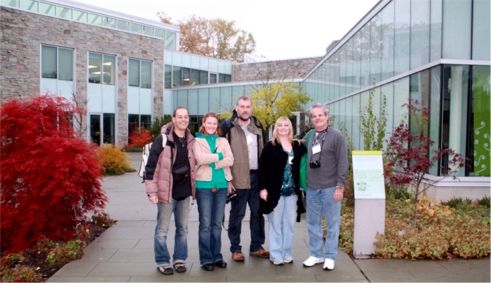
All in all we had a great time seeing old friends, although there wasn’t enough time to catch up with everyone! We were very impressed with the feel of the Congress, and felt like we really received a lot for our money. The receptions, coffee breaks, Tuesday lunch and barbecue dinner, and tours were all included in the Congress fee, which in comparison to other conferences was quite low at only $149 for members of GRHC, or $249 for non-members. Since my individual membership had expired, we finally bit the bullet and Greenroofs.com became a Corporate Member of GRHC for the first time.
My suggestions for future CitiesAlive! Congresses is to make the presentation sessions a 2-day event, not just one, and if possible, not have four concurrent tracks, but two. It was simply too much information in too little time. It works alright for the Greening Rooftops for Sustainable Communties Conferences, but they differ in that it is feasible for more than one person in a company to attend since you’re dealing with domestic travel (for most of us). People can swap notes, and in any case you get a CD with all the papers for later review. We also should have received a CD or booklet on the actual papers for this first Congress, which would have helped also since there were quite a few presentations that were hard to understand due to the breadth of international participants. I can’t believe I’m saying this, but I feel WGRIN could charge more in the future to help cover a 2-day event (keeping the tours included) which would be more beneficial to all.
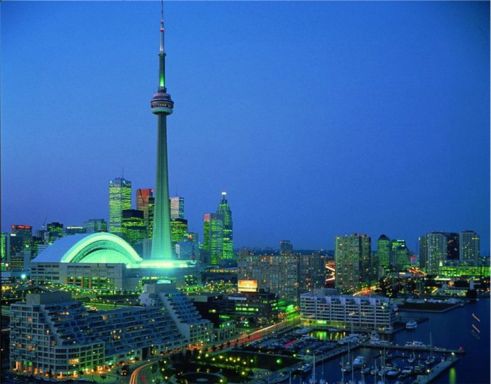
Toronto is a beautiful city with much to be proud – the last time we were here was in June of 2000, when I attended a green roof workshop by Steven Peck, when Green Roofs for Healthy Cities was a consortium of five companies. Attended by about 20 people including Steven, architect Monica Kuhn, Dr. Brad Bass (who showed Aramis and me his wonderful research of rooftop hydroponic plantings at the University of Toronto), greenroof designer/contractor Kaaren Pearson, John Beaudry, formerly with the Chicago Department of Environment, City of Chicago engineer Kevin LaBerge, and Marie-Anne Boivin of Soprema, among others, it was my first introduction to the fledgling greenroof community.
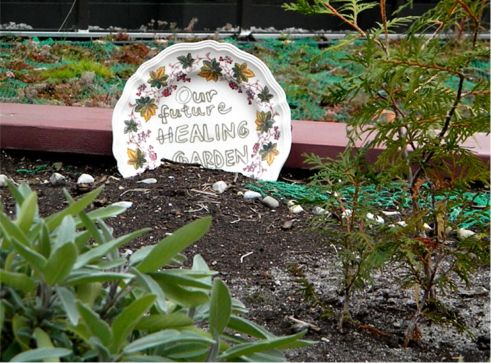
The kids at Covenant House Toronto have a spot reserved in their rooftop garden for future seeds of success. Our industry has come along way in the past 10 years and working together we can continue to promote healthy living architecture and make greenroofs and green walls standards within the architecture world, not just the green architecture world.
Happy Greening!
~ Linda V.
 Greenroofs.comConnecting the Planet + Living Architecture
Greenroofs.comConnecting the Planet + Living Architecture





Ashleigh Uiska
Hi Linda! Is it possible to tag Fishburn? that would be SOOOOOOO great!
Sky Gardens » Blog Archive » Christine’s Reflections on CitiesAlive!
[…] did a great job of summarizing the Fiesta, with wonderful photos, so if you haven’t read her blog post please do check it […]
Sky Gardens » Blog Archive » Roland Appl’s CitiesAlive! Photo Tour
[…] infrastructure practices, including greenroofs, green walls, and green streets. Christine and I both shared our experiences on two different “sustainable tours,” and now we invite […]
Sky Gardens » Blog Archive » 2009 Top 10 List of Milestones and Accomplishments
[…] (WGIN) – formerly the World Green Roof Infrastructure Network (WGRIN) - held its first CitiesAlive! World Green Roof Congress in Toronto, Canada, with the second scheduled for Mexico City this October, 2010. The […]
Growing Peppers
I did not know that Toronto has this infrastructure. I thought Vancouver was the best in Canada. I was wrong. I probably do some research about Toronto and I will include this in my lesson in my class. It is quite spectacular to see the pictures what Toronto could offer from other place.
Sky Gardens » Blog Archive » Reflections of Fall 2010 Greenroof Conferences: Mexico City, Part 1
[…] Roof Congresses that we’ve attended, both last year’s CitiesAlive! in Toronto (read my CitiesAlive! ‘09 Day Tour & Evening Fiesta and The Inaugural CitiesAlive! – Seeds of Success posts for more info, as well as Christine’s […]